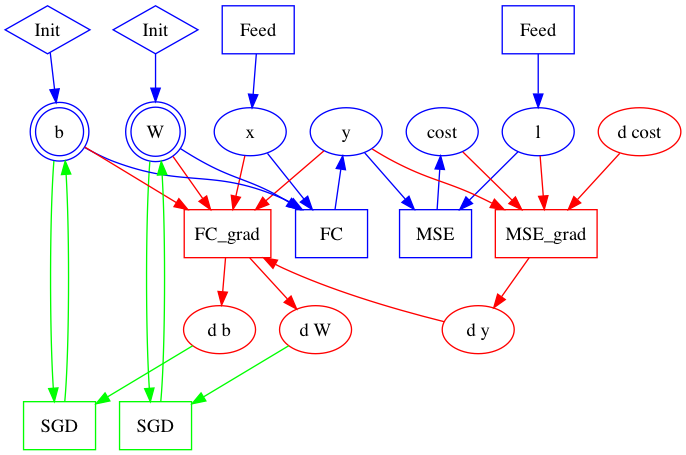Design Doc: Computations as a Graph¶
A primary goal of the refactorization of PaddlePaddle is a more flexible representation of deep learning computation, in particular, a graph of operators and variables, instead of sequences of layers as before.
This document explains that the construction of a graph as three steps:
- construct the forward part
- construct the backward part
- construct the optimization part
The Construction of a Graph¶
Let us take the problem of image classification as a simple example. The application program that trains the model looks like:
x = layer.data("images")
l = layer.data("label")
y = layer.fc(x)
cost = layer.mse(y, l)
optimize(cost)
train(cost, reader=mnist.train())
Forward Part¶
The first four lines of above program build the forward part of the graph.

In particular, the first line x = layer.data("images") creates variable x and a Feed operator that copies a column from the minibatch to x. y = layer.fc(x) creates not only the FC operator and output variable y, but also two parameters, W and b, and the initialization operators.
Initialization operators are kind of “run-once” operators – the Run method increments a class data member counter so to run at most once. By doing so, a parameter wouldn’t be initialized repeatedly, say, in every minibatch.
In this example, all operators are created as OpDesc protobuf messages, and all variables are VarDesc. These protobuf messages are saved in a BlockDesc protobuf message.
Backward Part¶
The fifth line optimize(cost) calls two functions, ConstructBackwardGraph and ConstructOptimizationGraph.
ConstructBackwardGraph traverses the forward graph in the BlockDesc protobuf message and builds the backward part.

According to the chain rule of gradient computation, ConstructBackwardGraph would
- create a gradient operator G for each operator F,
- make all inputs, outputs, and outputs’ gradient of F as inputs of G,
- create gradients for all inputs of F, except for those who don’t have gradients, like x and l, and
- make all these gradients as outputs of G.
Optimization Part¶
For each parameter, like W and b created by layer.fc, marked as double circles in above graphs, ConstructOptimizationGraph creates an optimization operator to apply its gradient. Here results in the complete graph:

Block and Graph¶
The word block and graph are interchangable in the desgin of PaddlePaddle. A Block is a metaphore of the code and local variables in a pair of curly braces in programming languages, where operators are like statements or instructions. A graph of operators and variables is a representation of the block.
A Block keeps operators in an array BlockDesc::ops
message BlockDesc {
repeated OpDesc ops = 1;
repeated VarDesc vars = 2;
}
in the order that they appear in user programs, like the Python program at the beginning of this article. We can imagine that in ops, we have some forward operators, followed by some gradient operators, and then some optimization operators.